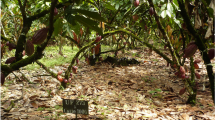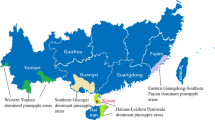Abstract
From four Korean pine (Pinus koraiensis) orchards, 60 clones were selected and analyzed for the fatty acid and amino acid components of the seeds to reveal the variations and correlations of the seed characteristics among the clonal source orchards and clones. The nutritional components of the seeds of the P. koraiensis trees exhibited rich genetic variation; the variation coefficient of the fatty acids was 2.24–66.83 %, while the variation coefficient of the amino acids was 14.70–38.88 %. Relatively high genetic-improvement potential exists for the nutritional components of the seeds. The phenotypic differentiation of the fatty acid and amino acid components reveals that variation within the population (85.18 %) was the primary source for the variation of the fatty acid components; variation among the orchards (63.08 %) was the primary source of the variation of the amino acid components. Data drawn from various clonal source orchards all showed that the seed characteristics were highly controlled by heritability (h2 > 80 %), and the seed characteristics of the P. koraiensis trees exhibited a similar genetic gain trend. The principal components were analyzed to obtain the comprehensive principal component value for each clonal seed orchard. Twelve clones were selected based on a clonal selection rate of 20 %. Correlation and multiple stepwise-regression analyses were conducted, considering different location conditions, to reveal the stable correlations between the seed characteristics to facilitate improvements of the seed yield of P. koraiensis trees and the clonal selection. Species of real characteristics in P. koraiensis were controlled by higher heritability. Genetic gain was obtained by selecting of superior clones.

Similar content being viewed by others
References
Bond B, Fernandez DR, VanderJagt DJ, Williams M, Huang YS, Chuang LT, Millson M, Andrews R, Glew RH (2005) Fatty acid, amino acid and trace mineral analysis of three complementary foods from Jos, Nigeria. J Food Compos Anal 18:675–690
Chen ZX, Lei ZX, Liu HN, Wu GY, Wang XB (2000) Analysis of chestnut ingredients and its integrated quality evaluation. J Fruit Sci 17(4):286–289 (In Chinese)
Fernandes DC, Freitas JB, Czeder LP, Naves MMV (2010) Nutritional composition and protein value of the baru (Dipteryx alata Vog.) almond from the Brazilian Savanna. J Sci Food Agri 90:1650–1655
Ferramosca A, Savy V, Einerhand AWC, Zara V (2008) Pinus koraiensis seed oil (PinnoThin (TM)) supplementation reduces body weight gain and lipid concentration in liver and plasma of mice. J Animal Feed Sci 17:621–630
Gomes RA Jr, Gurgel FdL, Peixoto LdA, Bhering LL, da Cunha RNV, Lopes R, Pina AJdA, Veiga AS (2014) Evaluation of interspecific hybrids of palm oil reveals great genetic variability and potential selection gain. Ind Crops Prod 52:512–518
Goroshkevich SN (2004) Natural Hybridization between Russian Stone Pine (Pinus siberica) and Japanese Stone Pine (Pinus pumila), USDA Forest Service Proceedings pp. 169–171
Greipsson S, Davy AJ (1995) Seed mass and germination behavior in orchards of the dune-building grass Leymus-Arenarius. Ann Bot 76:493–501
Hao YB, Wang KJ, Wang SL (2002) analysis of fatty acid composition in several early fruit Walnut protein. Food Sci 23(10):123–125 (In Chinese)
Kang KS, Lindgren D (1998) Fertility variation and its effect on the relatedness of seeds in Pinus densiflora, Pinus thunbergii and Pinus koraiensis clonal seed orchards. Silvae Genetica 47:196–201
LePage BA (2001) New species of Picea A. Dietrich (Pinaceae) from the middle Eocene of Axel Heiberg Island, Arctic Canada. Bot J Linn Soc 135:137–167
Li M, Liu Y, Sun C, Meng YN, Yang KQ, Hou LQ, Wang JY (2009) Research advance about nutrients and medicinal value of Walnut. J Chinese Cereals Oils Assoc 24(6):166–169 (In Chinese)
Lim TK (2012) Pinus koraiensis. Edible Medicinal and Non-Medicinal Plants. pp 297–303
Mahesh V, Shridhar KS (2006) Chemical composition of selected edible nut seeds. Food Feed Chem 54(13):4705–4714
Mensink RP, Katan MB (1990) Effect of dietary trans-fatty-acids on high-density and low-density-lipoprotein cholesterol levels in healthy-subjects. N Engl J Med 323:439–445
Miloun M, Militky J, Forina M (1992) Chemometric for analytical chemistry: PC-aided statistical data analysis, 1. Ellis Harwood New York
Mutke S, Gordo J, Gil L (2005) Variability of Mediterranean stone pine cone production: yield loss as response to climate change. Agric For Meteorol 132:263–272
Nasri N, Khaldi A, Fady B, Triki S (2005) Fatty acids from seeds of Pinus pinea L.: composition and population profiling. Phytochemistry 66:1729–1735
Nergiz C, Donmez I (2004) Chemical composition and nutritive value of Pinus pinea L. seeds. Food Chem 86:365–368
Pigliucci M, Murren CJ, Schlichting CD (2006) Phenotypic plasticity and evolution by genetic assimilation. J Exp Biol 209:2362–2367
Politov DV, Belokon MM, Maluchenko OP, Belokon YS, Molozhnikov VN, Mejnartowicz LE, Krutovskii KV (1999) Genetic evidence of natural hybridization between siberian stone pine, Pinus Sibirica du tour, and dwarf Siberian pine, P, Pumila (Pall.) Regel. Forest Genetics pp 41–48
Sathe SK, Seeram NP, Kshirsagar HH, Heber D, Lapsley KA (2008) Fatty acid composition of California grown almonds. J Food Sci 73:607–614
Savage GP (2001) Chemical composition of walnuts (Juglans regia L.) grown in New Zealand. Plant Foods Hum Nutr 56:75–82
Seeram NP, Kshirsagar HH, Heber D, Lapsley KA (2008) Fatty acid composition of California grown Almonds. J Food Sci 73(9):604–607
Sharma OC, Murkute AA, Kanwar MS (2010) Assessing genetic divergence in seedling trees of Persian walnut (Juglans regia). Indian J Agric Sci 80:360–363
Shen L, Wang X, Wang Z, Wu Y, Chen J (2008) Studies on tea protein extraction using alkaline and enzyme methods. Food Chem 107:929–938
Sun HQ, Li A, Ban W (2005) Morphological variation and its adaptive significance for Changnienia amoena, an endangered orchid. Biodivers Sci 13(5):376–386 (In Chinese)
Venkatachalam M, Sathe SK (2006) Chemical composition of selected edible nut seeds. J Agri Food Chem 54:4705–4714
Willett WC, Ascherio A (1994) Trans-fatty-acids—are the effects only marginal. Am J Public Health 84:722–724
Wolff RL, Deluc LG, Marpeau AM, Comps B (1997) Chemotaxonomic differentiation of conifer families and genera based on the seed oil fatty acid compositions: multivariate analyses. Trees Struct Funct 12:57–65
Wolff RL, Pedrono F, Pasquier E, Marpeau AM (2000) General characteristics of Pinus spp. seed fatty acid compositions, and importance of Delta 5-olefinic acids in the taxonomy and phylogeny of the genus. Lipids 35:1–22
Yoon TH, Im KJ, Koh ET, Ju JS (1989) Fatty-acid compositions of Pinus Koraiensis seed. Nutr Res 9:357–361
Zadernowski R, Naczk M, Czaplicki S (2009) Chemical composition of Pinus sibirica nut oils. Eur J Lipid Sci Technol 111:698–704
Zheng YL, Sun WB, Zhou Y, Coombs D (2009) Variation in seed and seedling traits among natural orchards of Trigonobalanus doichangensis (A. Camus) Forman (Fagaceae), a rare and endangered plant in southwest China. New Forest 37:285–294
Author information
Authors and Affiliations
Corresponding author
Additional information
Project funding: This work was supported by the Special Research of Public Welfare Forestry Industry for Financial Support for “Korean pine Improved Type Selection and Directive Breeding Technology Research (201204320)” and the Fundamental Research Funds for the Central Universities (2572014AA23).
The online version is available at http://www.springerlink.com
Corresponding editor: Hu Yanbo
Rights and permissions
About this article
Cite this article
Zhang, Z., Zhang, H., Yang, C. et al. Clonal variations in nutritional components of Pinus koreansis seeds collected from seed orchards in Northeastern China. J. For. Res. 27, 295–311 (2016). https://doi.org/10.1007/s11676-015-0154-5
Received:
Accepted:
Published:
Issue Date:
DOI: https://doi.org/10.1007/s11676-015-0154-5




